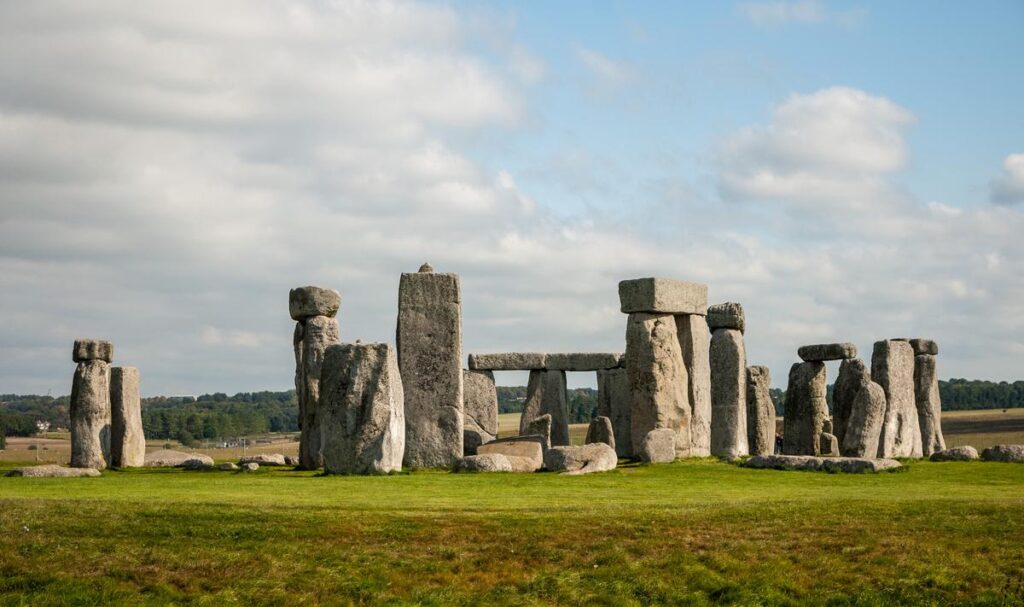Stonehenge, a timeless monument located in Wiltshire, England, has fascinated people from around the world for centuries. This iconic prehistoric site stands as a testament to ancient ingenuity and astronomical knowledge. As we delve into the mysteries of Stonehenge, we embark on a journey to uncover its enigmatic origins, explore the construction techniques employed by Neolithic builders, and unravel its symbolic significance. Join us as we unlock the secrets of this awe-inspiring monument.
The Ancient Enigma: Unveiling Stonehenge’s Origins
The origins of Stonehenge trace back over 4,500 years, and archaeologists and researchers have tirelessly sought to unravel its purpose. Various theories and speculations surround its construction, ranging from an astronomical observatory to a burial site or spiritual center. Let’s delve into the enduring allure of Stonehenge’s enigmatic beginnings.
Stonehenge has captivated the imagination of historians and archaeologists, who have proposed several theories about its origins. Some speculate that it was built as a celestial observatory, allowing ancient astronomers to track the movements of the sun, moon, and stars. Others believe it served as a burial ground for important individuals, with the arrangement of stones representing a sacred pathway to the afterlife. Another theory suggests that Stonehenge was a place of healing and pilgrimage due to its proximity to natural springs and ley lines, believed to possess spiritual energy.
Despite the numerous theories, the true purpose of Stonehenge remains elusive. The monument’s enigma continues to captivate our imagination, leaving us in awe of the ancient civilizations that created it.
Megalithic Marvels: Unveiling the Construction Techniques
The construction of Stonehenge is a remarkable feat of engineering, considering the enormous size and weight of the stones. The monument consists of two primary types of stones, the smaller “bluestones” sourced from Wales and the larger sarsen stones found locally. Let’s explore the techniques employed by Neolithic builders to transport and position these massive stones.
Transporting the bluestones from Wales to the Stonehenge site was no small feat. Researchers believe that ancient builders likely used a combination of sledges, rollers, and possibly even rafts to move the stones over land and water. The journey covered a distance of approximately 290 kilometers (180 miles), highlighting the immense effort involved in sourcing these stones.
Positioning the stones at Stonehenge required careful planning and precise engineering. One of the most intriguing aspects is the interlocking formation of the stones, which contributes to the monument’s stability. Neolithic builders created mortise and tenon joints, where one stone had protrusions and the other had corresponding indentations, allowing them to fit together seamlessly. This construction technique ensured the longevity and structural integrity of Stonehenge.
The mere existence of Stonehenge is a testament to the ingenuity and resourcefulness of the ancient builders. Their ability to transport and position these colossal stones without modern machinery is a marvel that continues to intrigue and inspire us.
Alignments with the Stars: Stonehenge and Astronomy
One of the most fascinating aspects of Stonehenge is its alignment with celestial events, particularly the summer and winter solstices. The alignment of the stones with the sun’s position during these solstices suggests that Stonehenge served as a celestial calendar, marking significant astronomical events. Let’s explore the astronomical significance of Stonehenge and the ancient astronomers who observed the heavens.
Stonehenge’s alignment with the solstices is no coincidence. During the summer solstice, the rising sun aligns with the Heel Stone, casting its first rays onto the center of the stone circle. This spectacle attracts thousands of visitors who gather to witness the magical play of light and shadow.
The alignment with celestial events demonstrates the deep understanding of astronomy possessed by the ancient builders of Stonehenge. They were able to accurately predict the changing seasons and mark important agricultural and religious events. Stonehenge’s astronomical significance serves as a reminder of the ancient world’s connection to the cosmos and its reverence for the celestial bodies.
Sacred Rituals and Spiritual Significance
Stonehenge’s enduring mystery extends to its religious and spiritual significance. The site’s layout and arrangement of stones suggest that it was used for various rituals and ceremonies. Let’s immerse ourselves in the ancient world of the Neolithic and Bronze Age people and explore the cultural and spiritual beliefs that may have led to the construction of this sacred site.
Stonehenge’s circular shape and alignment with celestial events are indicative of its role as a sacred space. Archaeological evidence suggests that Stonehenge was a site for communal gatherings, where people would come together to participate in rituals and ceremonies. It may have been a place of worship, where ancient communities sought spiritual guidance and connection with the divine.
The precise symbolism and purpose of the stone circle within Stonehenge remain a subject of speculation. Some believe that the arrangement of stones represents the cyclical nature of life and death, while others suggest that it symbolizes the union of the earthly and spiritual realms. Stonehenge’s enigmatic symbolism continues to intrigue researchers and visitors alike, offering a glimpse into the beliefs and practices of ancient civilizations.
Preservation and Protection: Stonehenge Today
As one of the most iconic and cherished sites in the world, Stonehenge requires careful preservation and protection. Efforts have been made to conserve this ancient monument and maintain its integrity for future generations. Let’s explore the ongoing initiatives aimed at safeguarding Stonehenge and the visitor facilities that provide insights into its history and archaeological research.
Stonehenge is now managed by English Heritage, an organization dedicated to preserving historic sites in England. They work tirelessly to protect the monument from natural and human-induced damage. Measures such as controlled access, ongoing research, and regular monitoring help ensure that Stonehenge remains intact.
Visitors to Stonehenge can explore the site through a visitor center that offers interactive exhibitions, educational displays, and guided tours. These facilities provide valuable information about the history, construction, and ongoing research surrounding Stonehenge. Visitors can engage with the rich heritage of the site and gain a deeper understanding of its significance.
Stonehenge’s preservation and protection are essential to maintain its cultural and historical value. By safeguarding this ancient wonder, we can continue to unravel its secrets and appreciate the legacy left by our ancestors.
Unraveling the Mysteries of Stonehenge
Stonehenge stands as a testament to human ingenuity and our fascination with the mysteries of the past. Its timeless allure and enigmatic origins continue to captivate our imaginations. Whether it be the alignment with the stars or the spiritual significance it held, Stonehenge beckons us to unravel its secrets and embrace the enduring mysteries of our human history.
As we gaze upon the mighty stone circles and contemplate the ancient rituals and beliefs they represent, we are reminded of the profound connection between humanity and the natural world. Stonehenge serves as a bridge between our modern lives and the ancient civilizations that came before us.
A visit to Stonehenge is more than just a journey through time; it is an opportunity to reflect on our place in the universe and the legacies we leave behind. Let Stonehenge’s ancient stones whisper their secrets to you as you stand in awe of this remarkable monument.
Conclusion
Stonehenge, with its enduring mysteries and timeless beauty, continues to captivate visitors from around the world. Its enigmatic origins, megalithic construction techniques, astronomical alignments, and spiritual significance make it a treasure trove of historical and cultural importance. The ongoing efforts to preserve and protect Stonehenge ensure that future generations can marvel at its wonders.
As we explore the mysteries of Stonehenge, we are reminded of the wisdom and ingenuity of our ancestors. From the transportation of massive stones to the precise alignment with celestial events, Stonehenge stands as a testament to human achievement and the eternal quest for knowledge.
A visit to Stonehenge is not only an opportunity to witness a marvel of ancient engineering but also a chance to connect with the past and contemplate the profound questions of our existence. Let Stonehenge’s ancient stones speak to you, whispering the secrets of a bygone era and inspiring a sense of wonder and awe.
Unlock the secrets of Stonehenge and embark on a journey through time. Discover the ancient wisdom that lies within its ancient stones and embrace the mysteries of our human history. Stonehenge awaits, offering a glimpse into the wonders of our past and a deeper appreciation for the world we inhabit.









